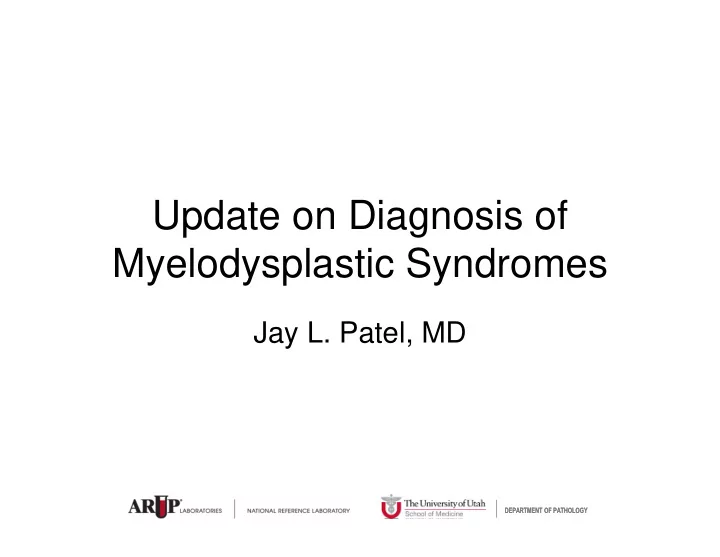

Update on Diagnosis of Myelodysplastic Syndromes Jay L. Patel, MD
Disclosure • None
Objectives • Review current diagnostic criteria pertaining to myelodysplastic syndromes • Understand the relevance of selected somatic gene mutations in the diagnosis and prognostication of myelodysplastic syndromes
WHO 2016 WHO 2008 MDS with single lineage Refractory cytopenia dysplasia MDS with multilineage Refractory cytopenia with dysplasia multilineage dysplasia MDS with ring sideroblasts* Refractory anemia with ring - Single lineage dysplasia sideroblasts - Multilineage dysplasia MDS with isolated del(5q)* MDS with isolated del(5q) MDS with excess blasts Refractory anemia with excess blasts MDS, unclassifiable MDS, unclassifiable
CBC Morphology Cytogenetics
Cytopenia? • Hemoglobin: <10 g/dL • ANC: <1.8 x10 9 /L • Platelets: <100 x10 9 /L
Morphology Cytogenetics CBC
Representative examples of morphologic abnormalities in myelodysplasia Mario Cazzola et al. Blood 2013;122:4021-4034
Limits of morphology • Patients with MDS may not show definitive morphologic evidence of dysplasia • Significant dysplasia may accompany non- neoplastic cytopenias • Dysplasia is not entirely reproducible among pathologists • Sample quality
Cytogenetics Morphology CBC
• May allow for a diagnosis of MDS in the absence of morphologic dysplasia
Limits of Cytogenetics • Up to 50% of patients with MDS have a normal karyotype • Non-specific abnormalities (e.g. del20q, trisomy 8, -Y) • May not be available
CBC Morphology Mutation Cytogenetics profiling
Blood. 2013 Dec 12;122(25):4021-34.
Genotype-phenotype relationships Blood. 2013 Dec 12;122(25):4021-34.
N Engl J Med. 2014 Dec 25;371(26):2488-98. N Engl J Med. 2014 Dec 25;371(26):2477-87.
Mutation happens Consider mutation frequency vs. disease incidence N Engl J Med. 2014 Dec 25;371(26):2488-98.
N Engl J Med. 2014 Dec 25;371(26):2488-98.
Clonal hematopoiesis of indeterminate potential (CHIP) • No morphologic evidence of malignancy • Exclude PNH, MGUS, MBL • Presence of a somatic mutation associated with myeloid malignancies – DNMT3A, TET2, ASXL1, SF3B1, TP53, JAK2, CBL, BCOR, BCORL1, SRSF2 – Variant frequency at least 2% • Risk of progression ~0.5-1.0% per year Blood. 2015 Jul 2;126(1):9-16.
Blood. 2015 Jul 2;126(1):9-16.
Blood. 2015 Jul 2;126(1):9-16.
If included as MDS, incidence could double! Blood. 2015 Jul 2;126(1):9-16.
Negative predictive value • Greater than 85% of patients with MDS have one or more somatic mutations (Papaemmanuil et al, Blood 2013) • If diagnosing MDS, a negative NGS result should prompt re-evaluation for other causes of cytopenia.
Do Variant Allele Frequencies help? • Somatic vs. germline • Cutoff for clinical relevancy? • VAF > 30% appears less common in CHIP N Engl J Med. 2014 Dec 25;371(26):2488-98.
Take home • Sequencing capabilities have advanced much faster than our understanding of genomics • Detection of somatic variant(s) alone is insufficient to diagnose MDS • For patients with possible MDS, integration of clinical history, CBC, morphology, conventional cytogenetics, and mutation data is essential • Data is accumulating…stay tuned (i.e. ‘MDS- related somatic mutations’? ‘IPSS-Mol’?)
Recommend
More recommend